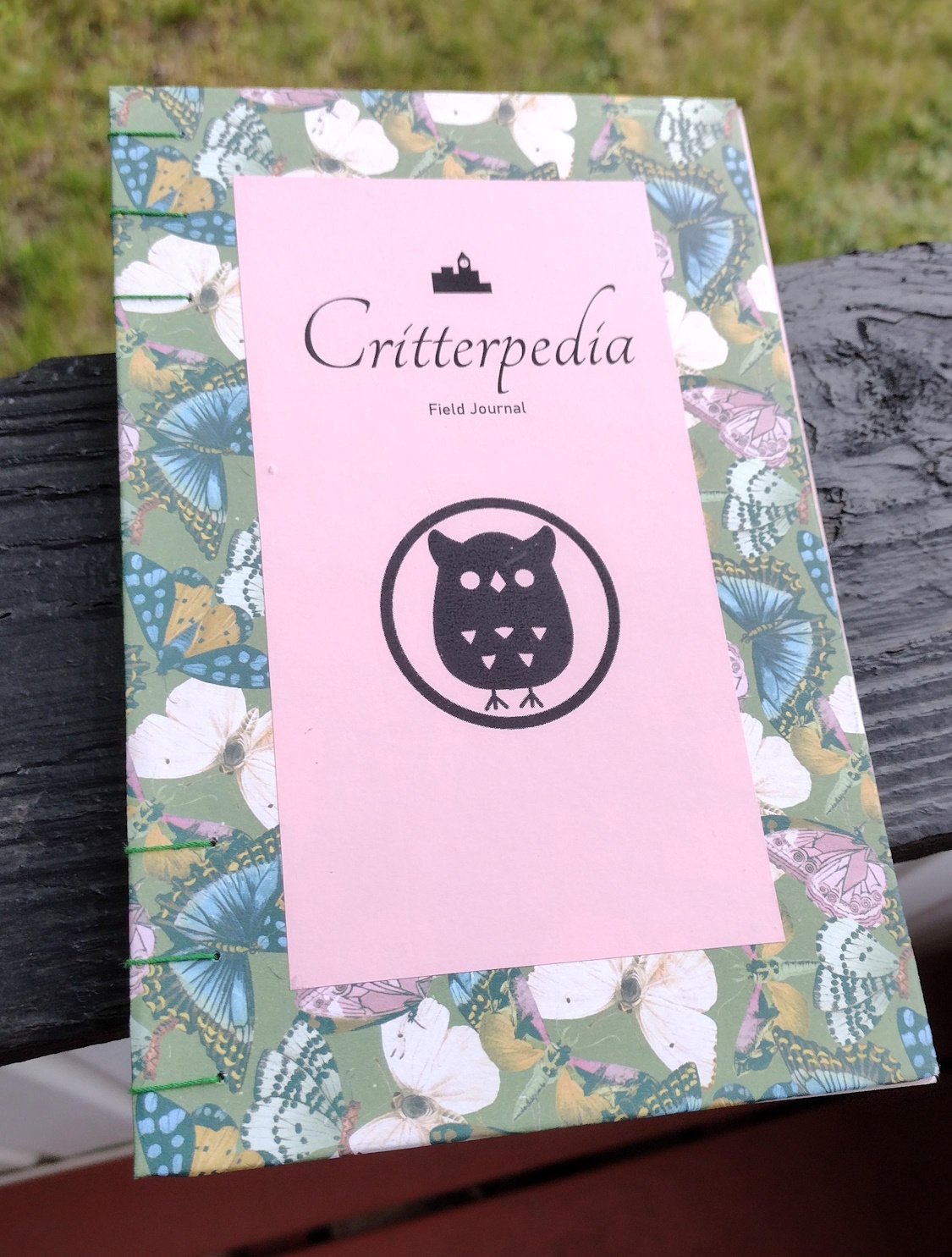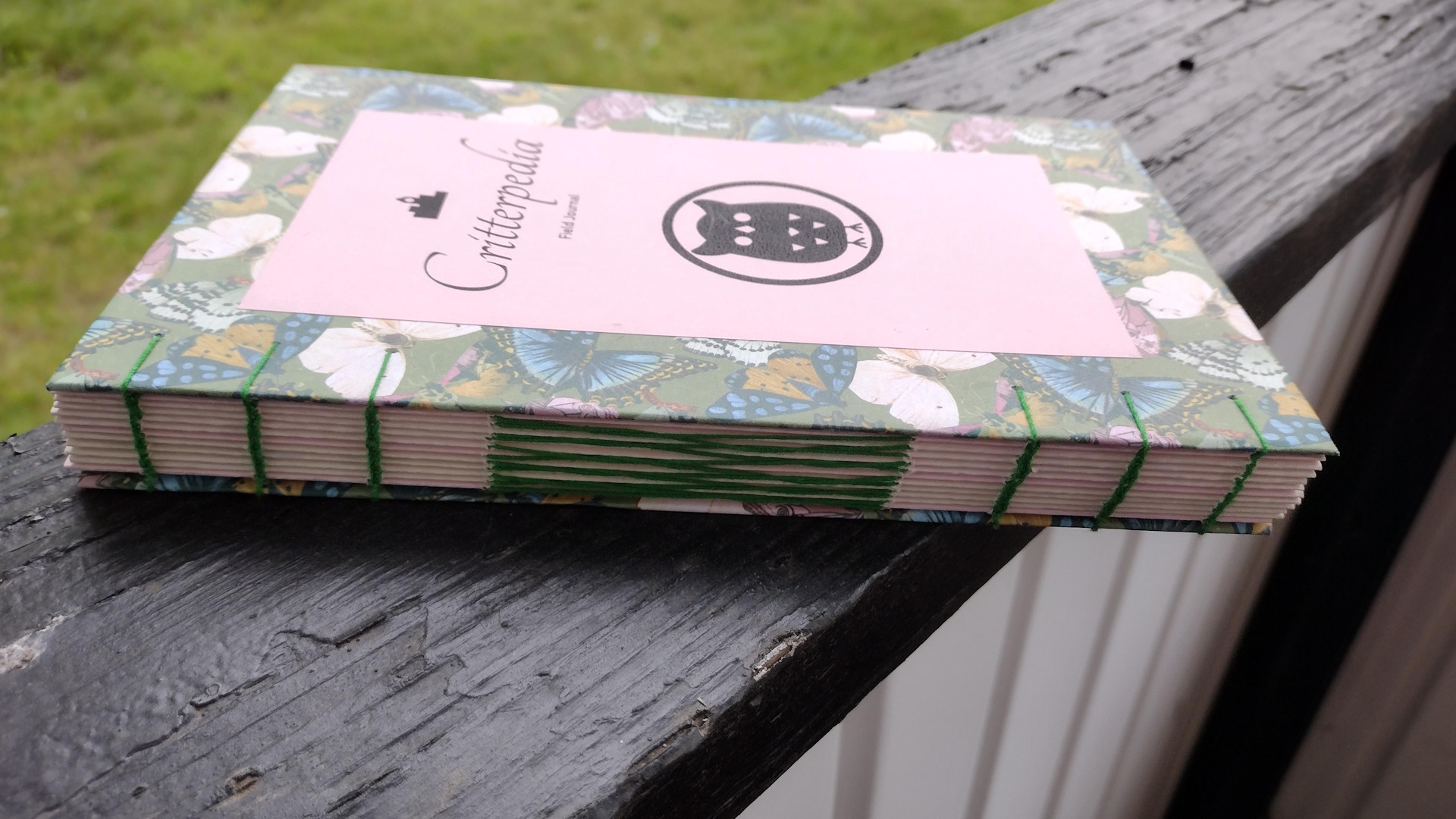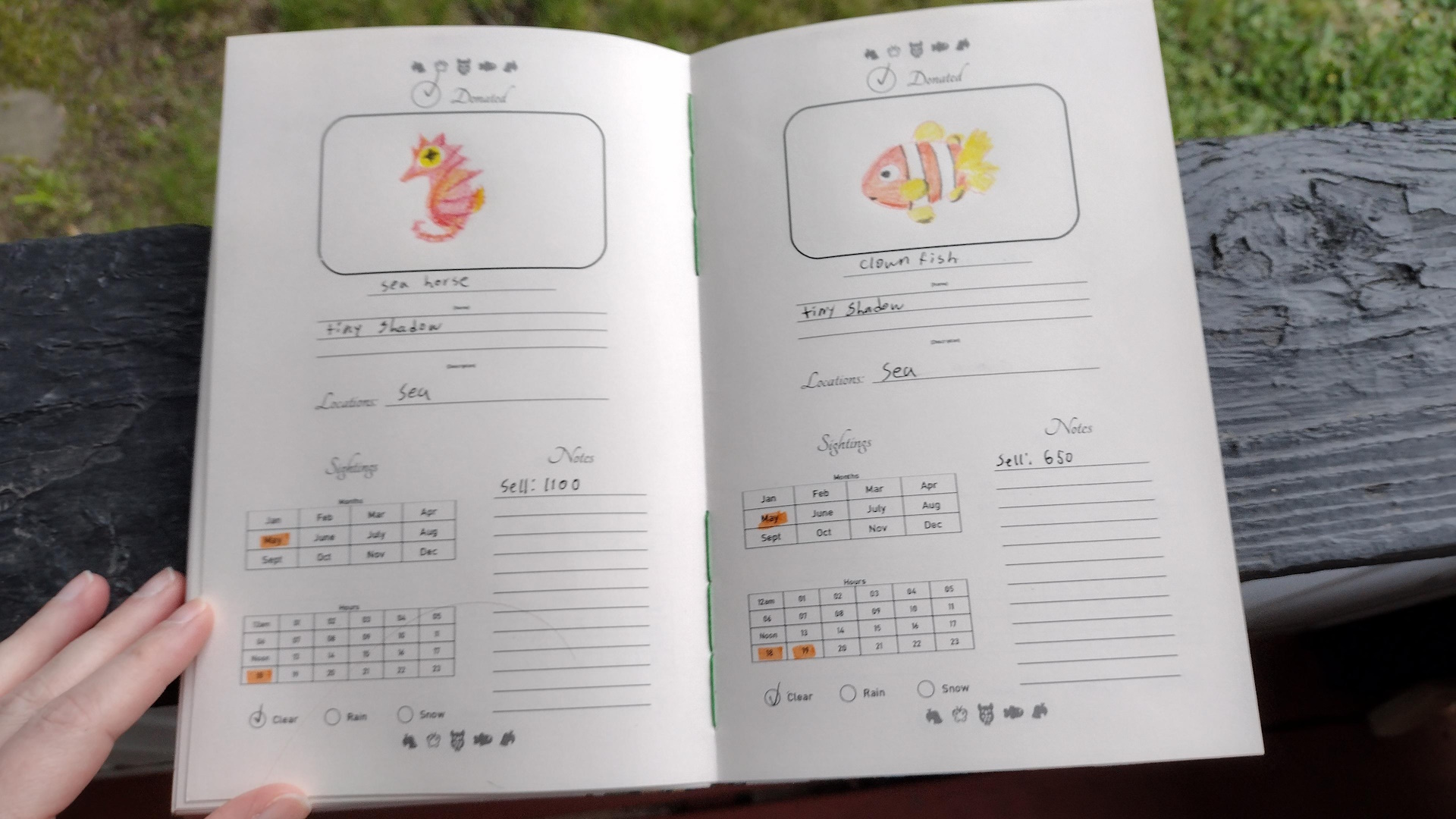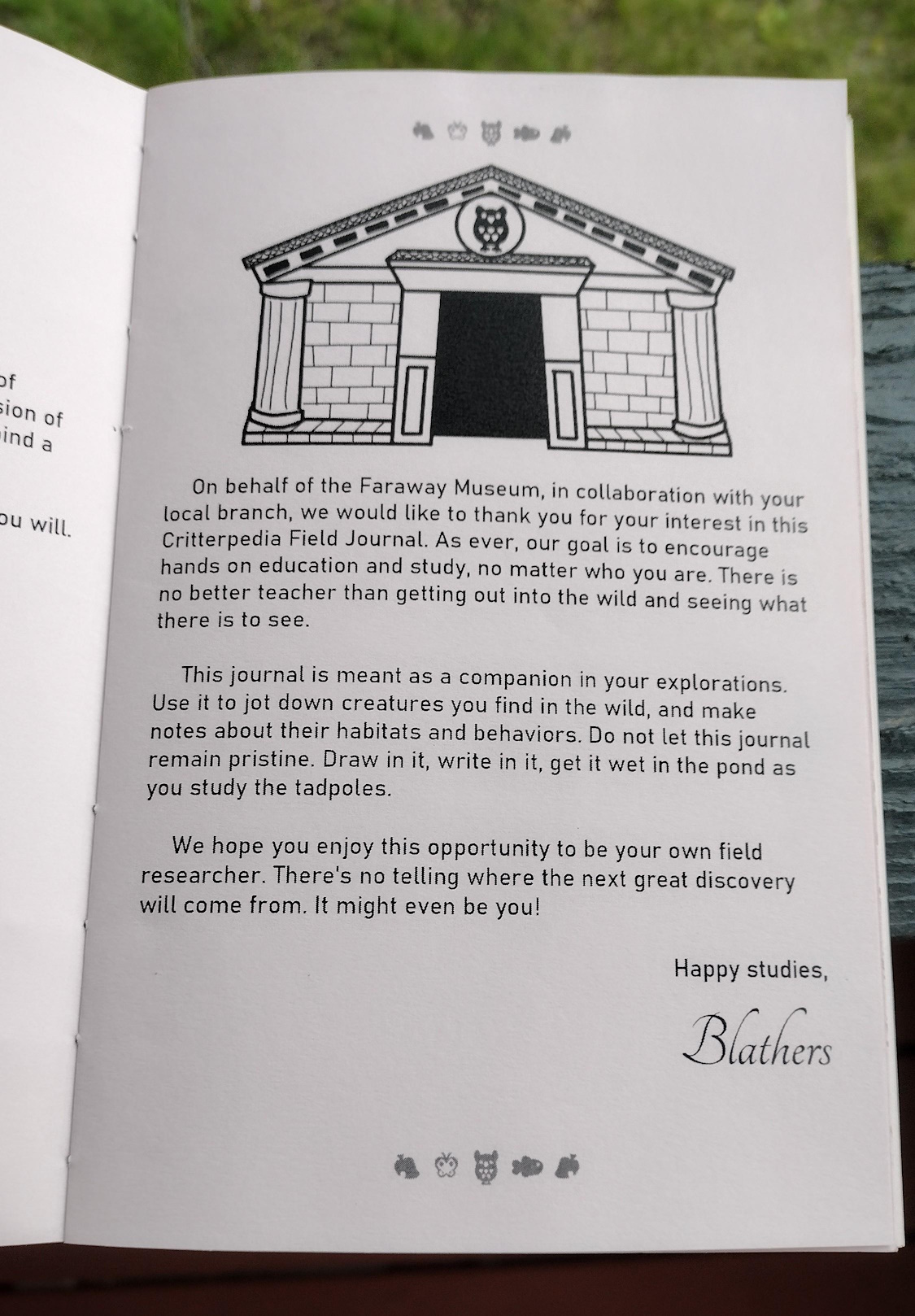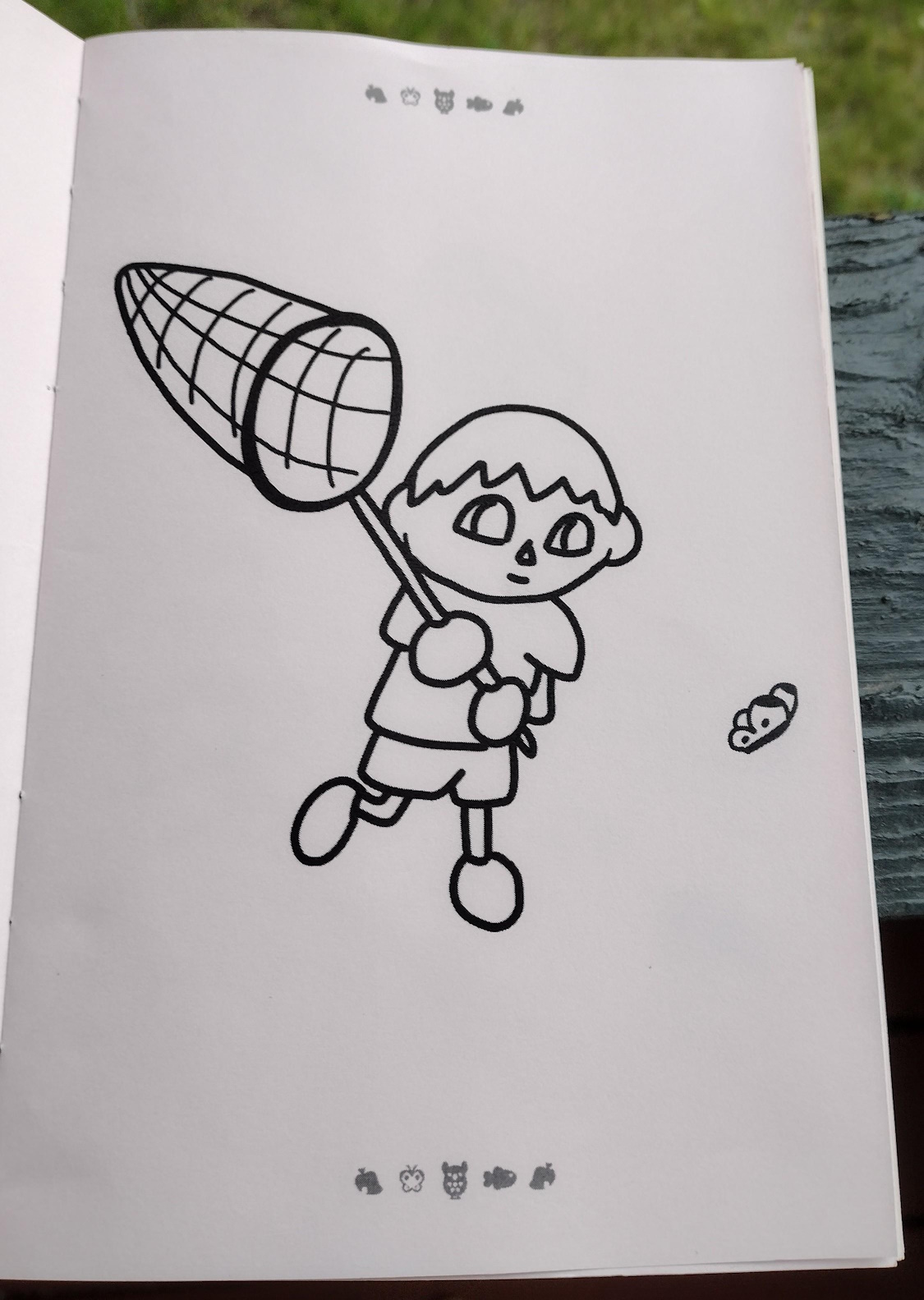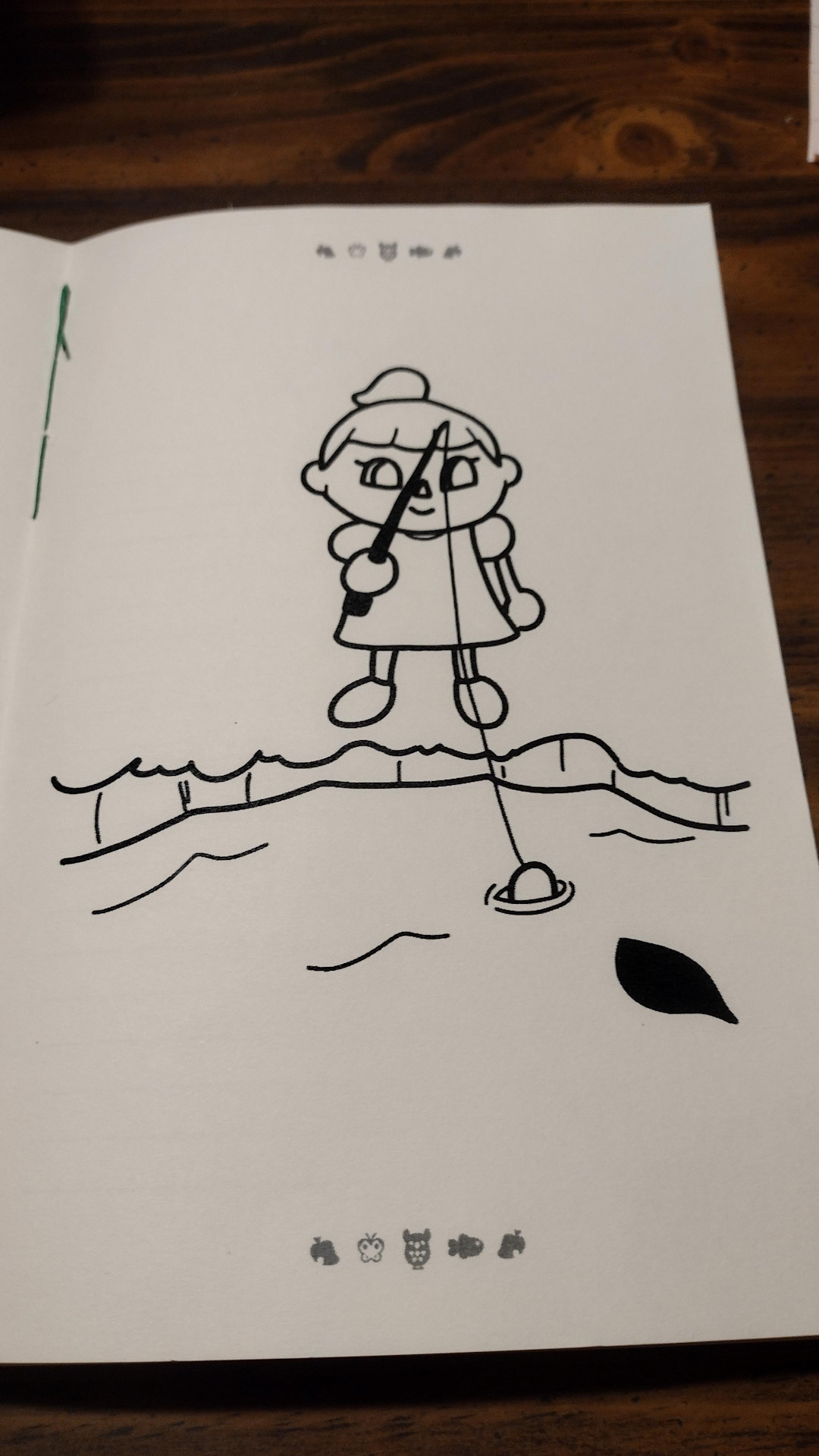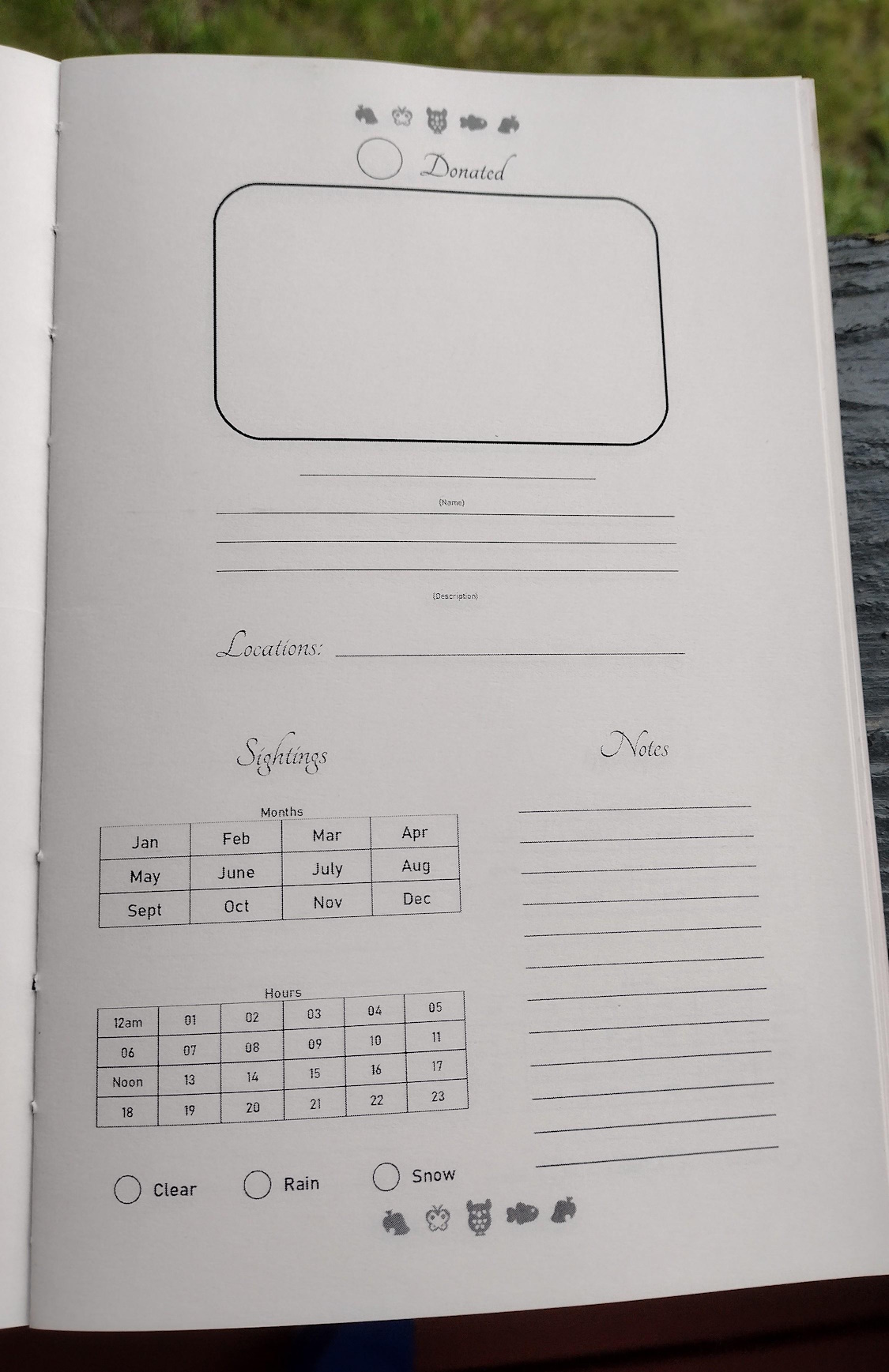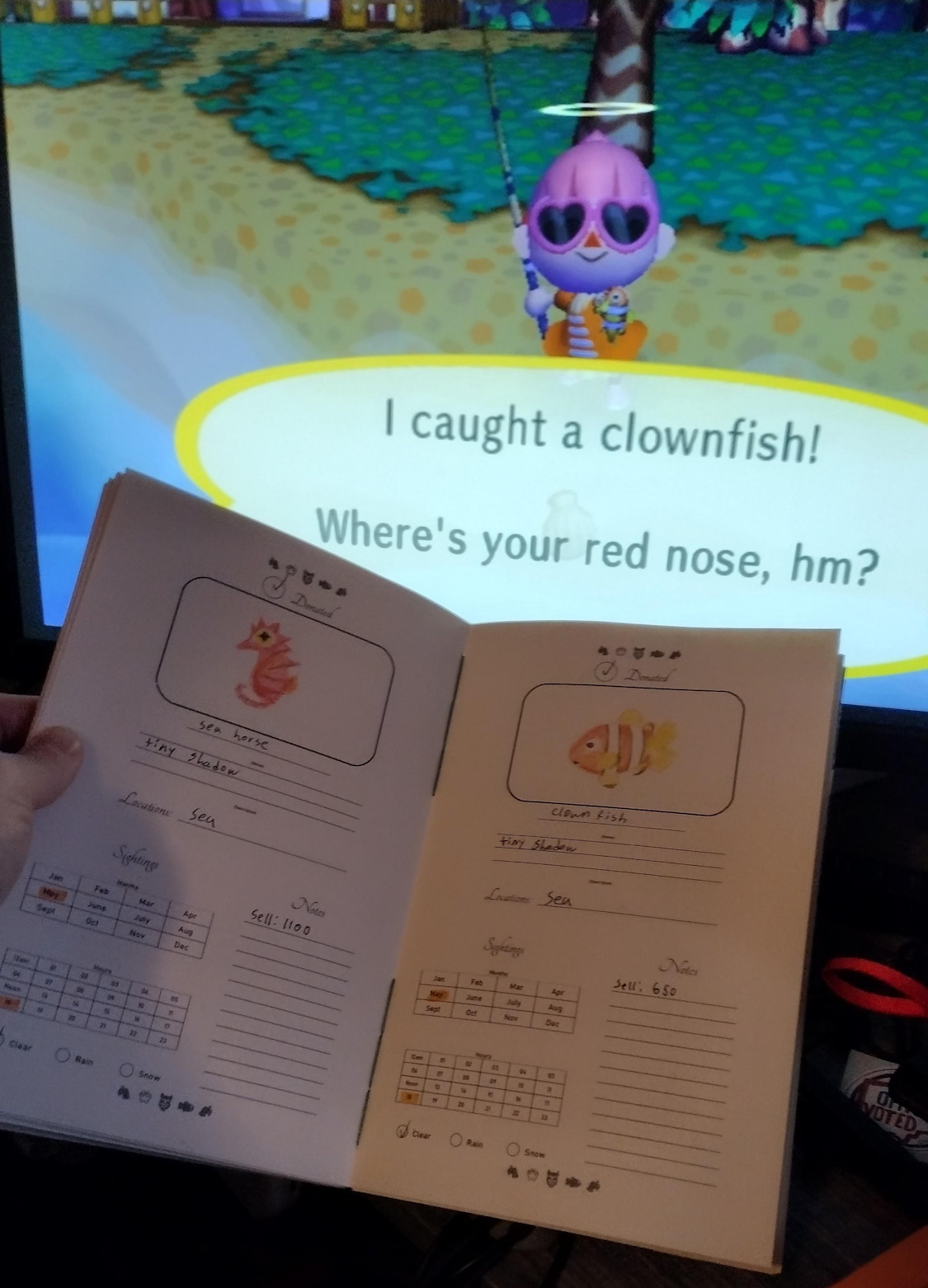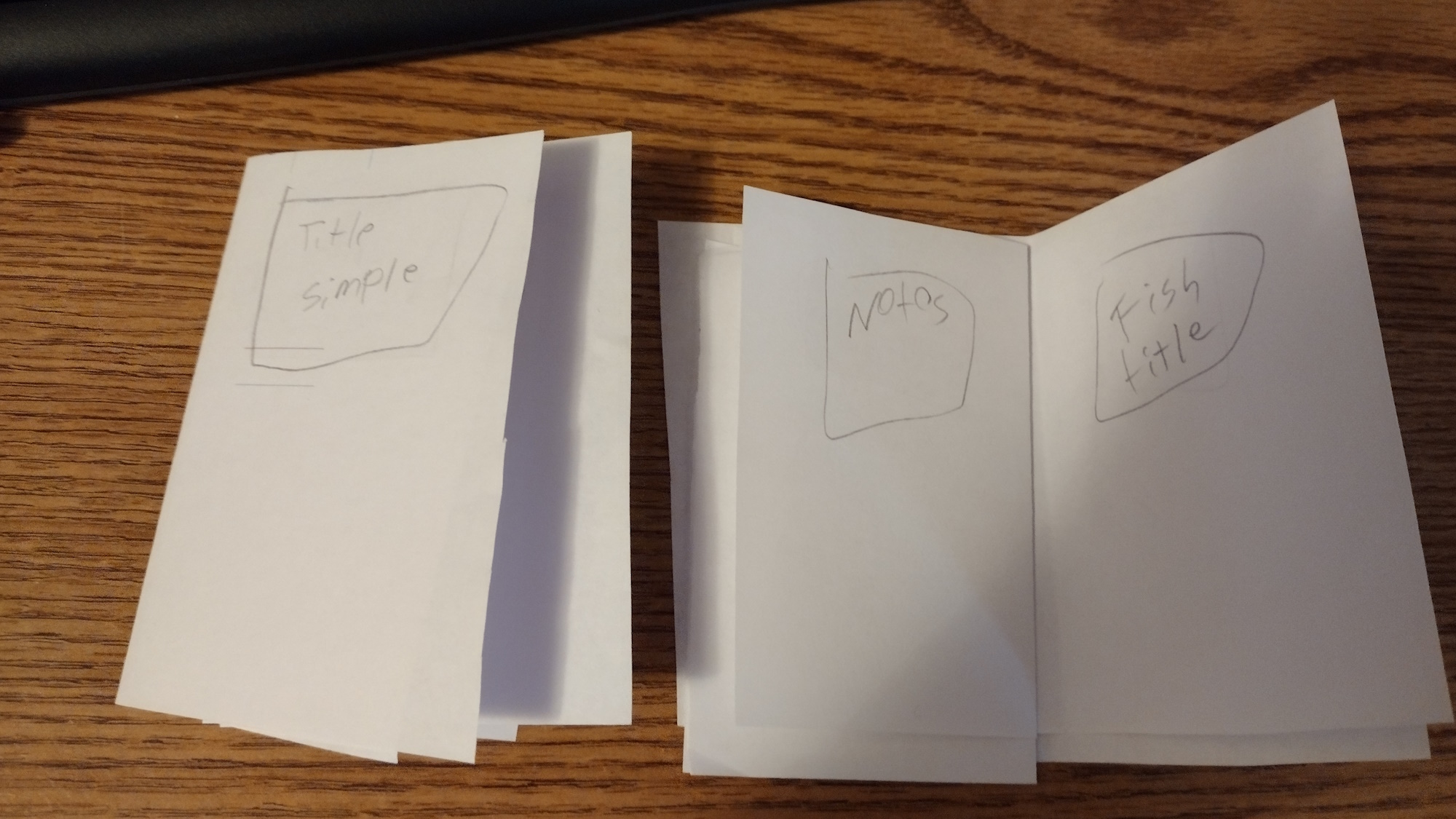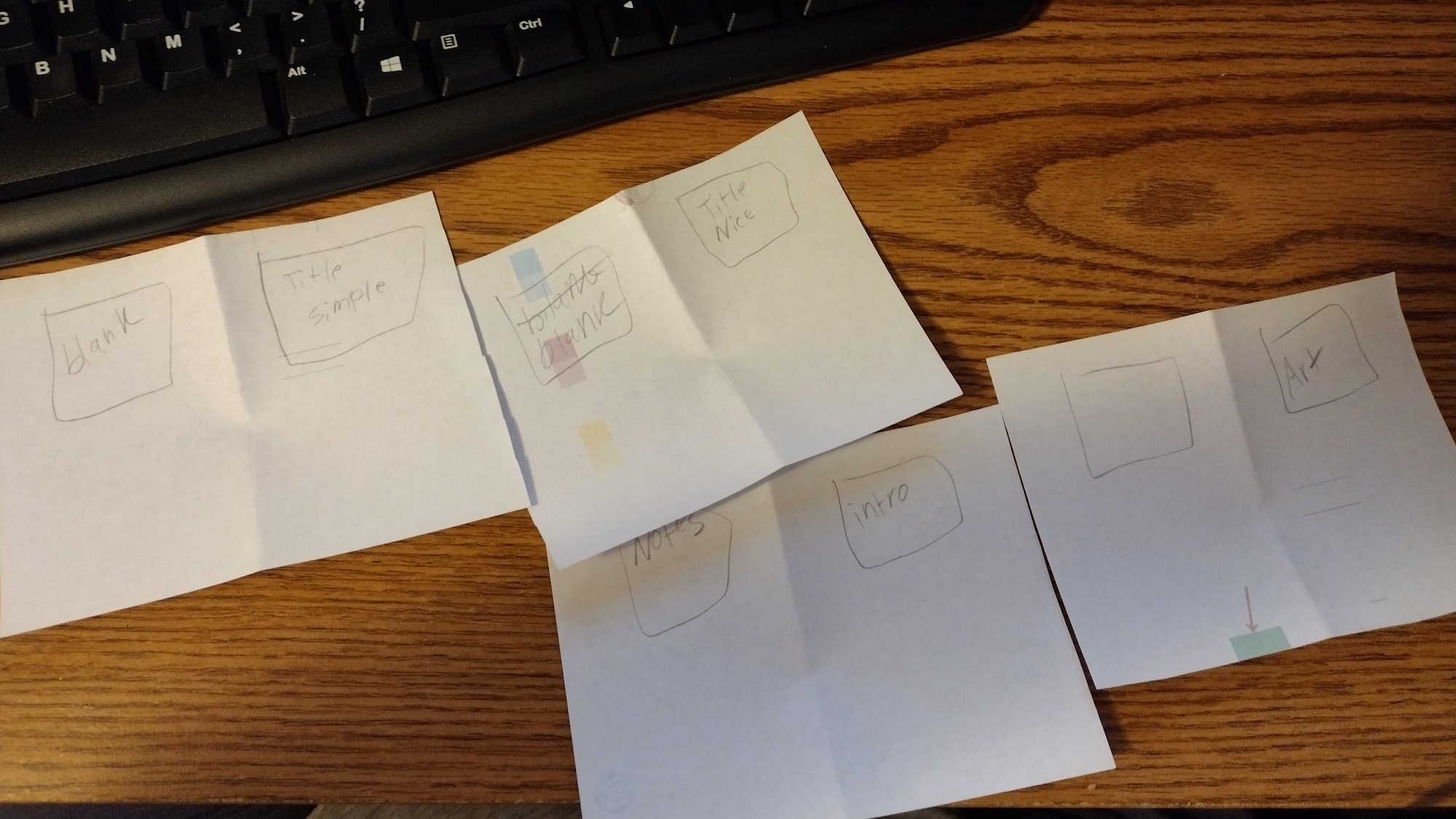Yirggzmb's Stuff
Topic: Animal Crossing
Back to Main - Back to Animal Crossing
Critterpedia Field Journal
A physical, "fill it in yourself", book for keeping track of creatures caught in Animal Crossing
A look inside mine!
The goal here was a journal that looks like it could exist inside the actual game, or at least as actual merch. The bulk of the book is made up of journal pages where you can record what you've found, when you've seen it, and all that jazz. Yes, it would be more efficient to look up when everything spawns via Nookipedia, but it's more fun (for me) to record my own experiences like this. I'm playing the game as if I were a kid, albeit a kid with access to a lot more craft supplies.
The rest of the book is assorted simple notes pages, and then a lot of filler to make it really come alive. Stuff like artwork, section dividers for the different types of critters, tips, an intro from "Blathers"... even a page emulating a typical copyright page. Everything in here, from the writing to the drawing, was created by me in a sort of fever dream of wanting it to be as cool and realistic as possible. It's definitely one of those projects I'm genuinely REALLY proud of.
(And before anyone says anything, I'm aware that "Critterpedia" in only the name in New Horizons. I just like it, ok?)
How to Make Your Own
Ok, so you're less interested in my gallery and are more interested in actually making something similar for yourself. Below you'll find some PDFs that ought to enable you to make something similar. I will apologize in advance, as the files are a bit of a mess. My raw open office files started getting very unwieldy and attempting to clean it up any more than I have just breaks things. Still, it should be serviceable. And though I made my journal for City Folk, there's also stuff in them that was designed with newer games in mind.
Files
All text, drawings, and page layouts by me. These files are shared for personal use, please. They're meant as potentially useful fan art.
-
Main pages - If all you want is the absolute basics, this is the pdf you want.
- Journal pages with Donated and Model checkboxes (NH) - Pages 1 & 2
- Journal pages with ONLY the Donated checkbox (PG-NL) - Pages 8 & 9
- Creature type section dividers (Fish, Sea Creatures, & Bugs) - Pages 4, 5, & 11
- Simple lines Notes pages - Pages 6 & 7
- Blank page with decorative header and footer - Page 10
- Genuinely blank page (for tricking my printer into behaving) - Page 3
-
Extra pages - Filler pages and stuff meant for "fluff"
- Blathers Intro - Page 2
- Fishing Tips - Page 3
- Bug Catching Tips - Page 4
- Diving Tips - Page 5
- Artwork - Pages 6, 7, & 8
- Simple Title - Page 9
- Fake Copyright - Page 10
- Blank Pages (for printer tricking) - Pages 1 & 11
-
All pages combined - If you want all the pages, this is the easier choice for printing
- This is both of the previous files, combined into one big one.
- This document is PURELY the two previous files glued together, random blank pages and all.
- When referring to page numbers, add 11 to the page numbers from the Extra document.
-
Covers - Simple cover designs, with extra padding/page size for if you want to print onto cardstock and wrap a book cover with them
- Animal Crossing (GCN) - Page 2
- Wild World (DS) - Page 3
- City Folk (Wii) - Page 4
- New Leaf (3DS) - Page 5
- New Horizons (Switch) - Page 6
- End Page (with player/town name spaces) - Page 7
- Blank page (for printer) - Page 1
-
Covers - less padding - What it says on the tin
- These files are identical to the previous Covers pdf, but they're sized to print the same as the regular pages
- These are useful if you'd like to print onto paper/cardstock and glue them onto an already wrapped cover
- They may also be useful for other types of book binding other than the one I used
All of the pages in my book were printed two to a side, on both sides, so that you could fold the paper hamburger style (with the short ends together) and have proper pages. You are not beholden to this, but the pages were designed with this in mind and may print funny if you opt to do something else.
Designing your Book
Before you start printing, first you need to decide which pages you want and how many of them. For starters, every game has a different number of creatures that can be caught. Which means a different number of journal pages for each.
| Game | Bugs | Fish | Sea Creatures | Total |
|---|---|---|---|---|
| Doubutsu no Mori (N64) | 32 | 32 | - | 64 |
| Animal Crossing (GCN) | 40 | 40 | - | 80 |
| Doubutsu no Mori e+ (GCN) | 48 | 48 | - | 96 |
| Wild World (DS) | 56 | 56 | - | 112 |
| City Folk (Wii) | 64 | 64 | - | 128 |
| New Leaf (3DS) | 72 | 72 | 30 | 174 |
| New Horizons (Switch) | 80 | 80 | 40 | 200 |
BOOK BINDING TERM ALERT - "Signatures". A signature is a stack of papers that have been folded in half. Commonly, this is somewhere between 3 and 5 sheets of paper. But there's no hard rules. I have used a single sheet "signature" of cardstock to make a cover before, and I own a commercially produced notebook that is a single signature of about 16 sheets. The main thing is that the fewer sheets you use the more likely it is to rip, and the more pages you use the harder it will be to fold. Thicker signatures also tend to have less even edges. Generally you'll use more sheets with thinner paper, and fewer sheets for thicker paper.
Because my PDFs were designed for printing two pages to a side, on both sides, a single sheet of paper contributes 4 pages to the book. Math then tells you that a four sheet signature is 16 pages. A three sheet one is 12 pages, and a five sheet one is 15. You probably didn't come here for math, but it's the best way to determine how much to print.
EXAMPLE - My book was for City Folk. That game has 64 bugs and 64 fish. This was convenient, because it meant that each section could be four signatures made up of four sheets. (4 sheets = 16 pages. 16 pages × 4 signatures = 64 pages) My printer doesn't do double sided printing. So to get the pages I needed, I set my printer to print 2 pages per sheet, and printed 32 copies of pages 8 & 9 in the main pages file. I then put it back into my printer going the other way and printed another 32 just the same.
If you (or I) make a version for a different game, the math will be different. Most numbers here are not very convenient for even signatures like my example. For most games, regardless of signature size, you'll probably have an uneven number. You could choose to round up and print extra journal pages. This is the easy choice, but will leave you with blank pages once you finish filling it in. Or, you can include some of the extra pages in the files. There's lined note pages, section dividers, etc. Blank pages are often useful as well. You may also wish to include signatures consisting entirely of other things.
For sheets that aren't just "print the same thing twice, and on both sides", you're probably going to want to make up a quick mockup. Take a single sheet of paper and cut it into (roughly) equal sized piced in the amount you want your signatures to be. I was using 4 sheets per, so I cut my paper into quarters. Then stack up these smaller pieces and fold them in half. You now have a mini signature. Get something to write with, and just loosely write what you want on each page like it's a tiny book.
You can then disassemble this mini mockup to see which pages you want to print on each sheet, and on which sides.
My specific book design
As an example, here are the signatures in my City Folk version, as if you were flipping through the book
- Beginning signature:
- Simple title page
- Blank
- Decorative title page (the cover design)
- Fake copyright page
- Intro
- Blank
- Bug art
- Blank
- Fish art
- Blank
- Notes
- Notes
- Bug divider
- Blank
- Bug tips
- Blank
- All journal pages
- All journal pages
- All journal pages
- All journal pages
- Section separator signature:
- Notes
- Notes
- Notes
- Blank (this was an accident, was supposed to be notes)
- Notes
- Notes
- Notes
- Notes
- Notes
- Notes
- Notes
- Notes
- Fish title
- Blank
- Fishing tips
- Blank
- All journal pages
- All journal pages
- All journal pages
- All journal pages
- All Notes pages
Even if you wish to make the exact book that I have made, you'll still want to make simple mockups for the sections with mixed page types. Attempting to describe it in text is beyond the scope of this page.
Materials
Book binding CAN use fancy supplies, but you can also use stuff you probably already have in the house. The nicer supplies can help ensure your book lasts a really long time, and if nothing else it's a good idea to try to make sure your supplies are acid free in order to help keep the paper from yellowing. But also not every book is meant to last a lifetime, so use what you've got access to and don't break the bank unless you just find you really love this as a hobby. Here's a list of things you will probably want, though the exact materials depends on how you wish to bind.
| Purpose | Pro option | Trip to the craft store | You already have this |
|---|---|---|---|
| Wrapping covers, and other gluing | Book binding glue | Craft glue (stick or liquid, labeled acid free) | School glue |
| Cover structure | Book board | Chipboard | Recycled cereal box |
| Cover decoration | Book cloth | Pretty cardstock | Regular paper you've drawn or printed on |
| The inside part of the cover | There's probably a fancy option for this | Cardstock | Regular paper |
| The pages | There's a lot of fancy paper out there | Heavier printer paper (24lb and up) | Regular (20lb) printer paper |
| For cutting | Heavy duty paper cutter with a swing arm | Craft paper cutter with a slider, or a craft knife and mat | Scissors |
| Poking sewing holes in signatures | Device specific for this task | Craft or sewing awl | Push pin |
| Sewing signatures | Waxed book binding thread | Nice thread and some beeswax | Embroidery floss, crochet thread, any light string |
| Needle for the sewing | There's probably fancy needles out there | Curve sewing needle | Any needle that fits your thread |
For my specific book, I was almost straight down the board with the middle option, with a few exceptions. My book covers are chipboard, covered in card stock. The front cover then has a piece of colored 24lb paper with the actual cover design printed onto it, and then glued directly onto the cardstock. The paper is 24lb paper from the craft store card making section. Cutting was mostly a cheap, portable, slider paper cutter also from the paper crafts section. The glue was Elmer's Glue-All. This is not an endorsement. The internet seems mixed on whether it counts as "acid free", and the bottle doesn't say, but I had it on hand already. I also did a bit with an Elmer's CraftBond stick, which IS labeled acid free. I just overall find liquid glue and a paintbrush easier to work with. Signatures and cover were pierced with a beading awl. The sewing was then crochet cotton sewn with a random curved needle I've had for decades.
I've also made other books where the pagers are litterally just loose leaf notebook paper, or the cover was made from a soda box. Not everything has to be super fancy, or even middling fancy.
Actually binding
I am still a novice in actually binding. I think it's possible for anyone who is at least a little crafty to come up with something nice, but I'll leave the actually explaining how to other people. Here's a list of tutorials and resources I think you might find useful:
- The PaperCraftPanda blog, which has all sorts of tutorials
- SeaLemon's french-link tutoral (specific video) that uses folded cardstock as a cover, no glue needed
- SeaLemon's tutorial (specific video) on making a cover like the one I made
- SeaLemon's tutorial (specific video) on coptic (chain) stitch binding
- The Ernie Studio's video (not a tutorial but a good view of the process) showing the mixed coptic/french-link style I used
- SeaLemon's tutorial playlist (this is a full playlist of different options)
This is by no means an exhaustive list, but these are the resources I found useful when I first started experimenting. I highly recommend just jumping in and trying anything that looks interesting, even if it's just a small test project
Credits/Thanks
- Fancy Font - Tangerine (link)
- SeaLemon tutorials and The Ernie Studio's video
- My friends Centuritron, Batronyx, and Dmynerd for helping brainstorm
- Nookipedia for critter counts
